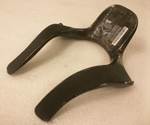Forging variations
Developed in parallel to the Duqueine Group’s (Massieux, France) MFP process, the high-pressure molding process used by Lentilly, France-based Carbone Forgé is described by Vincent Duqueine as “enabling forging of composites, similar to that done with metals.”
Developed in parallel to the Duqueine Group’s (Massieux, France) MFP process, the high-pressure molding process used by Lentilly, France-based Carbone Forgé is described by Vincent Duqueine as “enabling forging of composites, similar to that done with metals.”
Carbone Forgé describes itself as part of a group of European aerospace companies that is focused on improving the understanding of in-mold behavior of composite materials and simulating that behavior to create one-piece parts with complex geometries. In U.S. patent 6,884,379 B1, Vincent describes it as similar to the MFP process in that it uses prepreg between matched metal molds, but unlike his brother’s process, it does not use prepreg bundles. Like the Duqueine Group’s MFP process, however, the Carbone Forgé method also works with thermosets and thermoplastics to produce aerospace components and parts for sporting goods and other industries, including bicycle parts for Look Cycle International (Nevers, France). Carbone Forgé uses a proprietary mandrel made from “fusible core” washout material.
How the two brothers’ companies market their processes also differs widely: Vincent, at Carbone Forgé, works more with fabricators to license and adapt his process to their production needs, while Gilles has focused the Duqueine Group toward direct mass manufacturing.
The Duqueine Group’s VP/business development manager, Jérôme Aubry, who has worked with the brothers for many years, says the Carbone Forgé process works better with flat and long parts. For hollow parts, it incorporates meltable mandrel technology, which Aubry does not see as practical for the high-volume parts pursued by the Duqueine Group.
Related Content
-
3D-printed CFRP tools for serial production of composite landing flaps
GKN Aerospace Munich and CEAD develop printed tooling with short and continuous fiber that reduces cost and increases sustainability for composites production.
-
A new era for ceramic matrix composites
CMC is expanding, with new fiber production in Europe, faster processes and higher temperature materials enabling applications for industry, hypersonics and New Space.
-
Large-format 3D printing enables toolless, rapid production for AUVs
Dive Technologies started by 3D printing prototypes of its composite autonomous underwater vehicles, but AM became the solution for customizable, toolless production.













